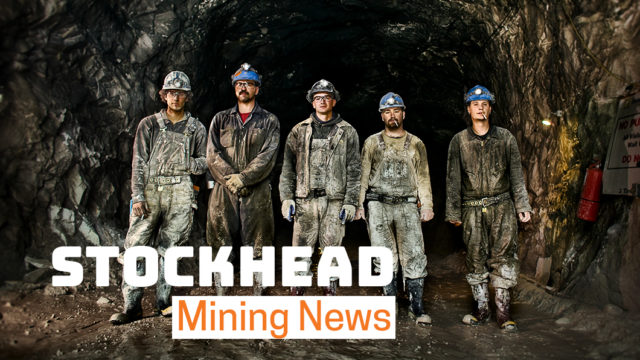Momentum is steadily building for uranium companies, as investors who have bet on the bottom for the past several years begin to see returns amid broader positive sentiment in the market.
Percolating in the background is a wave of optimism that nuclear energy will become a core part of the power mix as the world shifts away from fossil fuels and towards low-emissions power generation.
Much of that comes from the US, where nuclear power makes up around 20% of the national electricity market.
The Biden Administration is continuing plans from the Trump Presidency to establish a federal reserve of uranium, which would automatically increase the size of the market for yellowcake, while climate advisor Gina McCarthy has said publicly the White House sees nuclear power standing alongside wind and solar even after the decarbonisation of the grid.
Influencer investment firm Sprott Asset Management has also bet big on uranium, announcing an acquisition to launch a physical uranium commodity fund in April.
New York-listed Global X Uranium ETF, which is exposed to large and mid-cap uranium stocks in 23 developed and 24 emerging markets around the world is up 100% in the past year from $10.94 to $21.95.
ASX uranium stocks
Scroll or swipe to reveal table. Click headings to sort.
| CODE | COMPANY | PRICE | 1 WEEK RETURN % | 1 MONTH RETURN % | 6 MONTH RETURN % | 1 YEAR RETURN % | MARKET CAP |
|---|
| AGE | Alligator Energy | 0.038 | 0 | 12 | 322 | 744 | $87.6M |
| BMN | Bannerman Resources | 0.17 | 3 | -13 | 98 | 467 | $197.2M |
| EL8 | Elevate Uranium Ltd | 0.34 | -21 | 18 | 193 | 463 | $78.2M |
| PDN | Paladin Energy Ltd | 0.495 | 3 | -3 | 102 | 406 | $1.3B |
| VMY | Vimy Resources Ltd | 0.115 | -8 | -8 | 102 | 311 | $123.3M |
| DYL | Deep Yellow Limited | 0.7 | -10 | -16 | 48 | 235 | $238.0M |
| BOE | Boss Energy Ltd | 0.155 | -3 | -9 | 91 | 182 | $375.2M |
| PEN | Peninsula Energy Ltd | 0.16 | 2 | -7 | 55 | 117 | $162.1M |
| TOE | Toro Energy Limited | 0.019 | 0 | -24 | 36 | 111 | $68.5M |
| CXU | Cauldron Energy Ltd | 0.035 | -15 | -13 | -5 | 67 | $17.3M |
| LAM | Laramide Res Ltd | 0.525 | 0 | -13 | 50 | 50 | $632K |
| BKY | Berkeley Energia Ltd | 0.55 | -2 | -8 | -14 | 29 | $142.4M |
| TIN | Tnt Mines Limited | 0.165 | 10 | 6 | -37 | 14 | $15.9M |
| 92E | 92Energy | 0.31 | 3 | -11 | | | $11.8M |
| GTR | Gti Resources | 0.025 | 9 | 14 | 16 | -7 | $14.2M |
Australia’s most advanced junior developer Boss Energy (ASX: BOE) has enjoyed an even better run, climbing 182% in the past 12 months and 91% in the past 6 months to a market cap of $375 million.
Boss is aiming to bring the $107 million Honeymoon Uranium Mine in South Australia back into production after it was shut by previous owner Uranium One in 2013 due to falling prices.
Fully permitted, Honeymoon is in the box seat to ride higher prices to a spot as Australia’s third operating uranium mine after BHP’s Olympic Dam and Heathgate Resources’ Beverley, with a development timeframe of just 12 months.
An update of its feasibility study this week improved its pre-tax NPV by 35% to US$309 million, with EBITDA margins of 62%.
And process improvements are driving a 16% drop in sustaining costs to US$25.61, producing 22Mlbs of U3O8 over an 11 year life.
We caught up with Boss MD Duncan Craib to talk about the Honeymoon project, where he sees the market going and whether mainstream political support will emerge for nuclear power in Australia.
Spot prices are in the low US$30s at the moment, but we all know contract prices tend to be higher. Does the updated feasibility study give you a good sense of what price you would need to get back into production?
What we’re looking for is the spot price to start increasing and by that it would entail that the actual term contracts would be increasing.
Once we see the spot price moving and staying above the high US$30s we’ll be looking seriously at contracts, but our goal is really to create a profitable and sustainable mine.
While the spot price is currently higher than our all-in cost and we could be profitably producing at the moment we really want to maximum shareholder returns.
That could happen very quickly.
I’ve seen previously quoted that many operations would have been looking at US$50-65/lb to be sustainable and justify starting operations.
We’re really low cost and that was part of the study we released. Why we’re low cost is it’s in situ recovery which means you don’t have to have yellow fleet, open pit etc. so there’s significant savings there.
Secondly the (processing) method we’ll use is called iron exchange, which is a very efficient and low-cost method of production. The lowest cost operations in the world are the Kazakhstan operations and all of their operations are in situ recovery and iron exchange.
Of those two other operating mines in South Australia ,the Beverley mine is the same – in situ recovery and iron exchange – and that’s one of the world’s lowest cost producers as well, so we’re fortunate we can use that method of production and extraction of the resource.
When Uranium One shut down they were using solvent extraction. Can you explain what the difference is between that and iron exchange?
In a simplistic form when you leach the material from the wellfield, the method of leaching the resource is the same; you put through your lixiviant that helps leach the uranium, then you’ve got a pregnant leach solution that gets pumped to the process plant.
It’s that front end of the plant where you’ve got the solvent extraction or now the iron exchange. In solvent extraction a whole heap of other reagents get added to the pregnant solution in soluble form, and then you get a soluble condensed uranium that can go through the precipitation circuit.
The difference with iron exchange is that pregnant solution goes into NIMCIX columns and within those columns there are solid resin beads, and the uranium is attracted to those resin beads. You take those beads out and process it through the precipitation circuit.
And you’re reducing the risk of solvent contamination as well?
It’s not only that. With Honeymoon we’ve got 2600km2 of tenements. What iron exchange allows you to do is where you find an external resource, maybe 15-20km further away from the processing plant, you could build a small tailored IX column hosting the resin beads.
You then run a wellfield, you put that pregnant leach solution into the NIMCIX column, you process that onto the resin bead then transport the beads back to the processing plant.
So for us it suits our deposit so well.
Permitting can be pretty complex for uranium projects in Australia. But being a restart project you’re looking at 12 months from an investment decision to get into production.
For us the permitting is straight forward, we are fully permitted. When Uranium One was in production they actually got an export permit for 3.3Mlbs, and to get an export permit means that all your other permitting is in good order.
I’ve renewed the export permit 18-24 months ago, so we’re in good stead in that regard.
Generally speaking for a uranium project to get fully permitted in Australia it can be a long onerous task and around the world that’s also the case. There is a lot of red tape to go through.
It’s a qualitative aspect and it’s often overlooked in terms of how analysts actually put a value on it. But its paramount and it’s a very important aspect to a uranium mine.
It’s taken a very long time for uranium prices to recover since hitting their low in 2016A re investors patient with the time it’s taken the market to come back?
They are and they’ve done very well, they’ve had some fantastic returns (on their investment).
Our long term dedicated substantial shareholders such as Paradice, an Australian name, Tribeca, Sachem Cove, SEGRA out of the US, we’ve got some really strong supporters who participate in the raises we do who are very complimentary of the technical advancements we’ve made since acquiring the project and they really are committed to the longer term.
We’re certainly going to be one of the first mines to come back on globally and we’re low risk. It’s fully permitted, it’s a restart project so it’s not a mine yet to be built.
What we’re finding is it’s not so much the concern of existing shareholders being patient, we’re finding more generalist funds moving into the space.
A stat I read the other day is that over US$1 billion has gone into uranium equities since February, and the market is yet to even really start.
The Biden Administration in America accepts nuclear power is part of their no-emissions power mix. Do you think that will give investors more confidence to have uranium stocks in their portfolio, given the ESG filter investors now place on their picks?
Absolutely I do, with that government endorsement we’re seeing around the world. It’s really exciting because we experienced that in 2006-7, and I think it just bodes very well.
Generalist funds absolutely will be encouraged by that openness. We’re even seeing it in Australia, that more favourable leaning towards nuclear power, which is terrific.
It helps it become an investment that the generalist investor can see as being a long-term stable industry, which it is. The nice thing with Biden is it was one of the only bipartisan initiatives that was passed on from Trump to Biden.
A lot of the existing reactors in the US are now having their operational lives extended, which is fantastic.
They’re going from 40 to 60 years and there’s talk about some going to 80 years. That extension has been very well received in the industry.
In Australia there still remains a moratorium on building power stations here, do you see that changing over time?
I do, my feeling is that you would need both of the major political parties to come to an agreement, that is the way forward and we’re not there yet.
Certainly, the momentum seems to be building and in the past 12-18 months the number of newspaper articles coming out on the acceptance and willingness to embrace nuclear power is growing and I think that’s terrific.
I’m all for having an educated view on this as an energy source. It counts for 12% of the world’s supply. In America it’s 20% and in France it’s 70%, so very advanced economies around the world are reliant on nuclear and it’s proved highly successful for decades.
I think Australia, with a third of the world’s resource, should open its arms to it and it’s something we can do.
So you could make money at today’s price, but you are looking for a higher trigger is that right?
We do have a higher target price than that. I used a base case model price of US$60/lb in the study because over the life of the mine I think that’s a fair average that will be achievable.
But what history’s taught us is when the market runs it can move very quickly.
Given that primary production can’t come on straight away you can get a sudden violent move where operating cost switches to inducement pricing. Look at copper, look at iron ore, good examples of where that sort of pricing regime has flipped in the last 12 months.
In 2007-08-09 the spot prices were moving in dollars a week. Today we’re seeing a slow, incremental growth, but it can move really, really quickly.
That’s where it’s really, really exciting and that’s where you want to have positioned your mine to capitalise on it.
I think what we’re going to see is an increase in the spot price, I think you’ll see activity picking up in the third quarter of this year continuing into next year.
I think The Sprott-UPC deal is very positive for the market whereby they’re going to dual list on the New York stock exchange, it’s going to bring more demand in the near term and increased liquidity on the spot market and that will really get things moving.
You might be interested in












